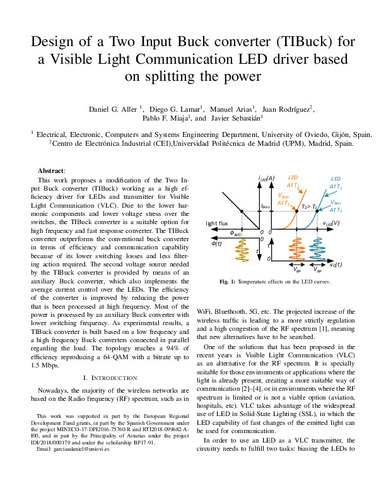Design of a Two Input Buck converter (TIBuck) for a Visible Light Communication LED driver based on splitting the power
Fecha de publicación:
Editorial:
IEEE
Versión del editor:
Resumen:
This work proposes a modification of the Two Input Buck converter (TIBuck) working as a high efficiency driver for LEDs and transmitter for Visible Light Communication (VLC). Due to the lower harmonic components and lower voltage stress over the switches, the TIBuck converter is a suitable option for high frequency and fast response converter. The TIBuck converter outperforms the conventional buck converter in terms of efficiency and communication capability because of its lower switching losses and less filtering action required. The second voltage source needed by the TIBuck converter is provided by means of an auxiliary Buck converter, which also implements the average current control over the LEDs. The efficiency of the converter is improved by reducing the power that is been processed at high frequency. Most of the power is processed by an auxiliary Buck converter with lower switching frequency. As experimental results, a TIBuck converter is built based on a low frequency and a high frequency Buck converters connected in parallel regarding the load. The topology reaches a 94% of efficiency reproducing a 64-QAM with a bitrate up to 1.5 Mbps
This work proposes a modification of the Two Input Buck converter (TIBuck) working as a high efficiency driver for LEDs and transmitter for Visible Light Communication (VLC). Due to the lower harmonic components and lower voltage stress over the switches, the TIBuck converter is a suitable option for high frequency and fast response converter. The TIBuck converter outperforms the conventional buck converter in terms of efficiency and communication capability because of its lower switching losses and less filtering action required. The second voltage source needed by the TIBuck converter is provided by means of an auxiliary Buck converter, which also implements the average current control over the LEDs. The efficiency of the converter is improved by reducing the power that is been processed at high frequency. Most of the power is processed by an auxiliary Buck converter with lower switching frequency. As experimental results, a TIBuck converter is built based on a low frequency and a high frequency Buck converters connected in parallel regarding the load. The topology reaches a 94% of efficiency reproducing a 64-QAM with a bitrate up to 1.5 Mbps
Descripción:
IEEE Applied Power Electronics Conference and Exposition (APEC) (35th. 2020. New Orleans, USA)
ISBN:
Patrocinado por:
MINECO/17-DPI2016-75760-R, RT2018-099682-A-I00; Principado de Asturias IDI-2018-000179
Colecciones
Ficheros en el ítem




